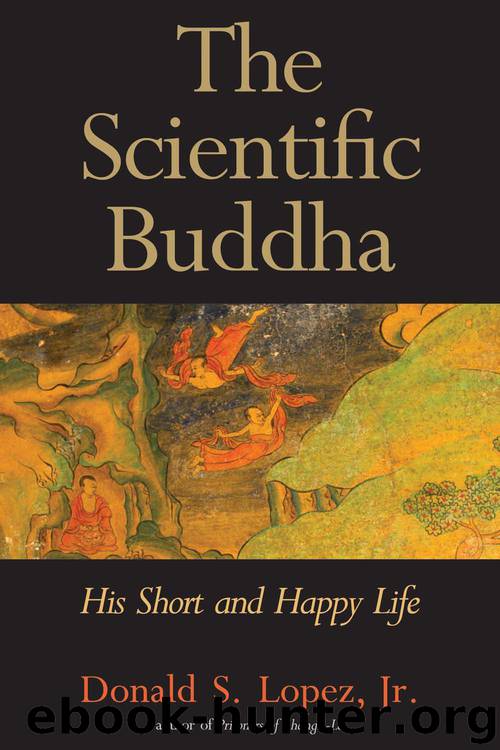The Scientific Buddha: His Short and Happy Life (The Terry Lectures Series) by Lopez Donald S

Author:Lopez, Donald S. [Lopez, Donald S.]
Language: eng
Format: azw3
Publisher: Yale University Press
Published: 2012-09-25T03:00:00+00:00
INTERLUDE
A Primer on Buddhist Meditation
An essential element in the modernization of meditation is the claim that a particular form of practice is not “religious.” It may be “Buddhist,” in the sense that its origin is attributed to the Buddha himself, but it is not part of a religious practice, not bound by time or by culture. Yet, although meditation may seek the timeless, its practice originated in time. As meditation, and especially what is described as Buddhist meditation, becomes an increasing focus of scientific research, it is perhaps useful to pause for a few moments to consider what meditation has meant in the history of Buddhism.
It is not the case, as it is sometimes claimed, that meditation is to Buddhism what prayer is to Christianity. Over the course of its long history across Asia, Buddhist laypeople have not been expected to practice meditation, nor have they done so. Meditation has traditionally been a practice confined to monks and nuns, and even then, not all monks and nuns have meditated, especially on a daily basis. Early Buddhist instructions for the design of a monastery state that a quiet area should be set aside for the meditating monks, suggesting that meditation was but one of a number of specializations in the traditional Indian monastery. There has also been long-standing debate over the importance of meditation versus the importance of the study of the scriptures. Around 35 B.C.E., a controversy developed in Sri Lanka as to whether the practice of meditation or knowledge of doctrine was more crucial to the preservation of Buddhism. The proponents of the latter position prevailed.
Nevertheless, since the early days of the tradition, meditation has been regarded as the practice par excellence in Buddhism, and the many stages along the Buddhist path, with attainments both mundane and transcendent, are to be achieved through the practice of meditation. The radical critiques of formal meditation that have occurred at various moments in the tradition (one thinks immediately of certain forms of zen) derive their radical quality from the fact that they challenge a practice that is so central to the tradition, in ways both symbolic and real.
The most common depiction of the Buddha, across the Buddhist world, is in the meditative posture, and the many accounts of the defining moment for the tradition, the Buddha’s enlightenment, say that he achieved enlightenment at dawn after a night of solitary meditation, seated beneath a tree. Exactly what his meditation practice was that night has been the subject of considerable commentary and conflicting claims over the long history of Buddhism. In the centuries after his death, an extensive literature on the theory and practice—and between these two, especially on the theory—of meditation developed in India.
As is so often the case in the study of Buddhism, one of the first issues to consider is that of translation. What Sanskrit term (or terms) is translated into English by “meditation,” and what is lost in translation? First, it is important to note that there is no single
Download
This site does not store any files on its server. We only index and link to content provided by other sites. Please contact the content providers to delete copyright contents if any and email us, we'll remove relevant links or contents immediately.
| Buddhism | Christianity |
| Ethnic & Tribal | General |
| Hinduism | Islam |
| Judaism | New Age, Mythology & Occult |
| Religion, Politics & State |
Cecilia; Or, Memoirs of an Heiress — Volume 1 by Fanny Burney(31341)
Cecilia; Or, Memoirs of an Heiress — Volume 3 by Fanny Burney(30938)
Cecilia; Or, Memoirs of an Heiress — Volume 2 by Fanny Burney(30897)
The Secret History by Donna Tartt(16644)
Sapiens: A Brief History of Humankind by Yuval Noah Harari(13067)
Leonardo da Vinci by Walter Isaacson(11913)
The Radium Girls by Kate Moore(10914)
Sapiens by Yuval Noah Harari(4546)
The Wind in My Hair by Masih Alinejad(4427)
How Democracies Die by Steven Levitsky & Daniel Ziblatt(4407)
Homo Deus: A Brief History of Tomorrow by Yuval Noah Harari(4287)
Endurance: Shackleton's Incredible Voyage by Alfred Lansing(3852)
The Silk Roads by Peter Frankopan(3771)
Man's Search for Meaning by Viktor Frankl(3645)
Millionaire: The Philanderer, Gambler, and Duelist Who Invented Modern Finance by Janet Gleeson(3574)
The Rape of Nanking by Iris Chang(3522)
Hitler in Los Angeles by Steven J. Ross(3444)
The Motorcycle Diaries by Ernesto Che Guevara(3341)
Joan of Arc by Mary Gordon(3263)
